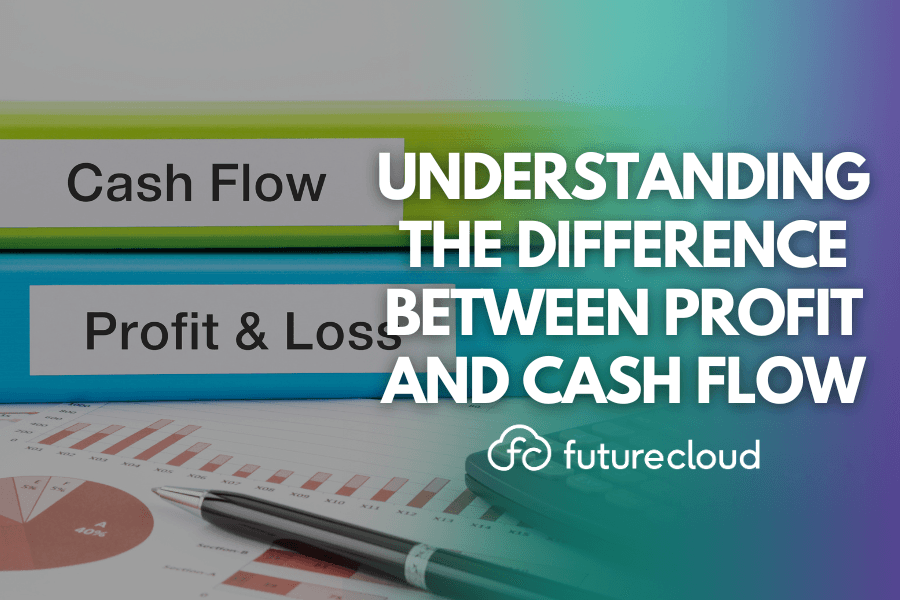Some business owners think that if their business is showing a profit, it must mean everything’s fine financially. Unfortunately, that’s not always the case, and not understanding the difference between profit and cash flow is something that can cause real headaches, even for otherwise successful businesses.
Let’s go through the differences between them and give you a better idea of why both matter, and how they impact the day-to-day running of your business.
What exactly is profit?
Profit (also known as net profit) is what’s left over after your business has paid all of its expenses, including costs of goods sold, salaries, rent, marketing, and tax. It’s the figure shown on your profit and loss statement, and it tells you whether your business is making money overall.
Sounds straightforward enough. But here’s where things get a little misleading, profit is often based on accrual accounting, meaning it includes money you’ve earned but haven’t actually received yet. So, for example, you might have made a big sale and issued an invoice, which shows up as profit. But if that customer hasn’t paid you yet, you don’t actually have that money.
So, while your profit figure might look healthy on paper, your bank account might tell a very different story.
What is cash flow, then?
Cash flow is all about the actual money that flows in and out of your business bank account. It tracks when you receive money and when you spend it, which is what you really need to manage on a daily basis.
So, even if your business is technically profitable, if your customers are slow to pay or your outgoings are higher than expected, you could quickly find yourself short on cash.
Positive cash flow means you’re bringing in more money than you’re spending. Negative cash flow means the opposite, and that’s where the problems start.
Why does the difference between profit and cash flow matter?
You can be profitable and still end up in financial difficulty. This is one of the biggest surprises for new (and even established) business owners.
Let’s say you’ve just had a fantastic quarter. Orders are up, profits look strong. But if those profits are tied up in unpaid invoices, or you’ve spent heavily on stock or new equipment, you might not have enough actual cash to pay your suppliers, staff, or HMRC when they come calling.
This is especially critical in the UK, where you’re expected to stay on top of:
- Quarterly VAT returns
- Corporation Tax payments
- PAYE and NI contributions
If you don’t have the cash set aside, things can go south quickly.
Cash flow issues are one of the most common reasons small businesses fail, not because they weren’t profitable, but because they ran out of cash.
How does this affect day-to-day decisions?
If you’re only looking at your profit, you might think you’ve got room to hire someone new, take on a big project, or invest in new tools or technology. But if you’re not watching your cash flow, those decisions can come back to bite you.
Cash flow affects your ability to:
- Pay wages and bills on time
- Cover PAYE, VAT and other tax liabilities
- Manage slow periods or sudden expenses
- Invest in opportunities without putting the business at risk
In short, cash is what keeps the wheels turning, and profit is just part of the bigger picture.
What can you do to stay on top of both?
Here are a few things that can really help business owners stay in control:
- Keep your bookkeeping up to date – using cloud software like Xero, QuickBooks or FreeAgent makes it easier to track both profit and cash.
- Issue invoices promptly – and don’t be shy about chasing up overdue payments. Consider setting shorter payment terms (e.g., 7 or 14 days instead of 30).
- Build a cash buffer – even having a few months of costs saved can reduce a lot of stress.
- Use a cash flow forecast – plan out the next 3–6 months of inflows and outflows so you’re not caught off guard.
- Review regularly – don’t just look at your year-end accounts. Monthly or quarterly financial reviews are key, especially for VAT-registered businesses or those with fluctuating income.
- Get help from an accountant – the main one! Don’t try to manage it all on your own. A good accountant can take the financial pressure off you, help you forecast accurately, and make sure your business stays on track.
Which one matters more?
Truthfully, you need both. Profit tells you how sustainable your business is over the long term. Cash flow tells you whether you can actually survive from month to month.
If there’s one takeaway here, it’s don’t get caught out by only watching your profit. Make cash flow part of your regular financial routine, not just something you look at when things feel tight.
Knowing the difference (and managing both) will give you more control, better decision-making, and a lot less stress in the long run.
Got questions about cash flow, profit, or your numbers in general?
Get in touch, we’re here to help!
Your friendly, forward-thinking, accountants!
And don’t forget to follow us on social media for the latest updates, tips, and more!




